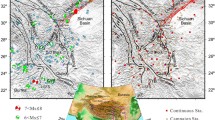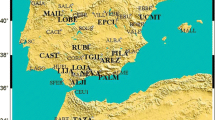Abstract
This work analyzes recent crustal deformation and strain accumulations in continental China based on GPS and seismicity data. Since the early 1990s, several regional GPS networks for active tectonic studies were established in continental China. All of these networks were surveyed in campaign mode at one to two year intervals and have been conducted on a scale ranging from several hundred kilometers to a few of thousands kilometers. Each individual network was originally designed to address local problems without attempting to measure the large-scale deformation of continental China, and therefore can’t be merged together seamlessly, due to different data analysis strategies involved, to yield a uniform velocity field (Bannette, et al., 1999). The only realistic approach for a large-scale GPS solution to date is to merge the original observations from different regional networks into a coherent solution. According this strategy, a uniform velocity field in 1TRF97 frame on continental China scale was obtained (Wang, et al., 2001). It appears that Tibetan Plateau itself absorbs most of the deformation caused by collision and penetration between India and Eurasia. More than 80% of the relative motion is accommodated by convergence within the Plateau. The North China and South China blocks, east of the Tibetan Plateau move coherently at a rates of 10 to 14 mm/yr with respect to the stable Eurasia
We perform a joint inversion of seismicity data and 338 GPS velocities in continental China for a self-consistent velocity field, strain rate field. The model velocity field is expanded as bi-cubic spline interpolation functions defined within a 2° × 2° grid that covers the country and extends into the assumed rigid India and Eurasian plates to south and north. The inversion jointly minimizes the magnitudes of fitted strain rates and the misfit to the observed velocity data. The spline technique allows high spatial resolution of strain rate variations, especially in regions with spatially dense GPS data. Our results show that the maximum strain rate is located along the South-North tectonic zone, Chuan-Dian block, these are the most intensive neotectonic deformation areas in continental China.
Access this chapter
Tax calculation will be finalised at checkout
Purchases are for personal use only
Preview
Unable to display preview. Download preview PDF.
Similar content being viewed by others
Reference
Beavan, J. and John Haines, Contemporary horizontal velocity and strain rate fields of the Pacific-Australian plate boundary zone through New Zealand, J. Geophys. Res., 106, 741–770,2001.
Beavan, J., et al., Crustal deformation during 1994–1998 due to oblique continental collision in the central Southern Alps, New Zealand, and implications for seismic potential of the Alpine fault, J. Geophys. Res., 104, 25,233–255,1999.
Bennett, R. A., J. L. Davis, and B. P. Wernicke, Present-day patterns of Cord Hieran deformation in the western United States, Geology, 27, 371–374, 1999.
Bennett, R. A., W. Rodi, and R. Reilinger, Global Positioning System constraints on fault slip rates in southern California and northern Baja, Mexico, J. Geophys. Res., 101, 21. 943–21,960, 1996.
Bevis, M., et al., Geodetic observations of very rapid convergence and back-arc extension at the Tonga arc, Nature, 374,249–251,1995.
Bourne, S. J., T. Arnadottir, J. Beavan, D. J. Darby, P. C. England, B. Parsons, R. I. Walcott, and P. R. Wood, Crustal deformation of the Marlborough fault zone in the South Island of New Zealand: Geodeitc constraints over the interval 1982–1994, J. Geophys. Res., 103, 30,147–30.166, 1998.
Ding GY., Lu Y.Z. A preliminary analyze of present-day motion in the intraplate of China, Chinese Science Bulletin, 18.1412–1415,1986.
Feigl, K. L., et al., Space geodetic measurements of crustal deformation in central and southern California, 1984–1992, J. Geophys. Res., 98, 21,677–32,712, 1993.
Haines, A. J., Calculating velocity field across plate boundaries from observed shear rates,Geophys. J.R.Astr Soc.,68, 203–209, 1982
Haines, A. J., J. A. Jackson, W. E. Holt, and D. C. Agnew, Representing distributed deformation by continuous velocity fields, Sci. Rep. 98/5, 100pp., Inst. Of Geol. And Nucl. Sci., Lower Hurt, New Zealnad, 1998
Haines, A.J., and W.E. Holt, A procedure for obtaining the complete horizontal motions within zones of distributed deformation from the inversion of strain rate data, J.Geophys. Res., 98,12057–12082,1993
Holt, W. E., and A. J. Haines, The kinematics of northern South Island, New Zealand, determined from geologic strain rates, J. Geophys Res., 100, 17,991–18,010, 1995.
Holt, W.E., N. Chamot-Rooke, X. Le Pichon, A.J. Haines, B. Shen-Tu, and J. Ren, Velocity field in Asia inferred from quaternary fault slip rates and GPS observations, J.Geophys. Res., 105, 19,185–19,209,2000
Jackson, D. D., Z-K. Shen, D. Potter, X. -B. Ge, and. Sung, Southern California deformation, Science, 277, 1621–1622, 1997.
Kato, T., G. S. El-Fiky, E. N. Oware, and S. Miyazaki, Crustal strains in the Japanese islands as deduced from dense GPS array, Geophys. Res. Lett., 25, 3455–3449, 1998.
Kostrov, V. V., Seismic moment, energy of earthquakes, and the seismic flow of rock, IZV. Acad.Sci.USSR Phys. Solid Earth, Engl.Transl. 10, 23–44,1974
Kreemer, C. and W.E. Holt, Active deformation in eastern Indonesia and the Philippines from GPS and seismicity data, J.Geophys. Res., 105, 663–680,2000
Larson, K. M., R. Bürgmann, R. Bilham, and J. T. Freymueller, Kinematics of the India-Eurasia collision zone from GPS measurements, J. Geophys. Res., 104, 1077–1093,1999.
Ma, X., et al., Lithospheric Dynamics Atlas of China, China Cartographic Publishing House, Beijing, 1989.
McCaffrey, R. Oblique plate convergence, slip vectors, and forearc deformation, J. Geophys. Res., 97, 8905–8915, 1982
McCaffrey, R., Active tectonics of the eastern Sunda and Banda Arcs, J. Geophys. Res.,93,15163–15182,1988
Puspito, N.T., and K. Shimazaki, Mantle structure and seismotectonics of the Sunda and Banda arcs. Tectonophysics, 251, 215–228,1995
Shen-Tu, B., W. E. Holt, and A. J. Haines, Intraplate deformation in the Japanese islands: A kinematic study of intraplate deformation at a convergent plate margin, J. Geophys. Res., 100, 24,275–24,293,1995.
Shen-Tu, B., W. E. Holt, and A. J. Haines, The contemporary kinematics of the western United States determined from earthquakes moment tensors, VLBI and GPS observations, J. Geophys. Res., 103, 18,087–18,118, 1998.
Straub, C, and H. -G Kahle, Active crustal deformation in the Marmara Sea region, N.W. Anatolia, inferred from GPS measurements, Inst, of Geod. and Photogramm. ETHZ Mitt., 58„1996.
Taylor, F. W., et al., Geodetic measurements of convergence at the New Hebrides island arc indicate arc fragmentation caused by an impinging aseismic ridge, Geology, 23, 1011–1014,1995.
Wang Qi, Zhang Peizhen, Jeffrey T. Freymueller, et al, Presentday crustal deformation in China constrained by Global Positioning System measurements, Science, 294, 574–577, 2001.
Author information
Authors and Affiliations
Editor information
Editors and Affiliations
Rights and permissions
Copyright information
© 2002 Springer-Verlag Berlin Heidelberg
About this paper
Cite this paper
Xu, C., Wang, Q., Liu, J., Dong, L., Wang, H. (2002). Recent Crustal Deformation and Strain Accumulations in Continental China Inferred from GPS and Seismicity Data. In: Ádám, J., Schwarz, KP. (eds) Vistas for Geodesy in the New Millennium. International Association of Geodesy Symposia, vol 125. Springer, Berlin, Heidelberg. https://doi.org/10.1007/978-3-662-04709-5_86
Download citation
DOI: https://doi.org/10.1007/978-3-662-04709-5_86
Publisher Name: Springer, Berlin, Heidelberg
Print ISBN: 978-3-642-07791-3
Online ISBN: 978-3-662-04709-5
eBook Packages: Springer Book Archive




